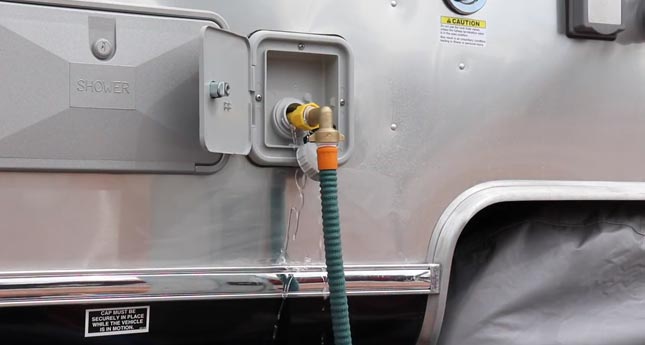Last Updated on May 29, 2023
When freshwater sits in an RV tank for an extended period, it may lead to many problems, including unsafe drinkable water and water-borne diseases. To avoid any health hazards, you must have some understanding of how to drain RV fresh water tank.
For RV owners, the most significant thing you need to do before traveling with one is to drain the tank. Once you have finished using your RV for the season, you must drain the RV fresh-water tank. This prevents damage caused by ice expansion when the ground freezes in winter.
The process of draining an RV’s tank can be challenging at first glance if you do not know what to expect or how to proceed. Let’s discuss how to drain RV freshwater from the holding tank without wasting time.
Tools for Draining Fresh Water Holding Tank
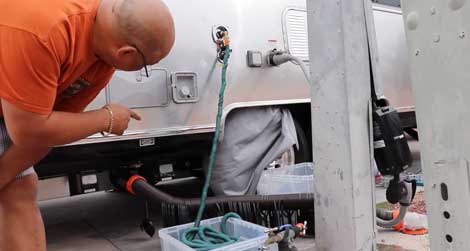
To ensure a smooth draining process, it is important to have the right tools on hand. There are certain tools that you must need in order to drain the fresh water tanks of RVs, such as:
- Water sewer hose
- Water pressure regulator
- Potable water hose adapter
- A spigot wrench
- Drain pan / Bucket
- Rags/ Paper towels
How to drain RV fresh water tank – Step By Step Process
You will eventually need to drain the RV fresh water tank to remove any sediment or bacteria that have built up. Draining the fresh water tank on your RV is a relatively simple process, but it’s important to do it correctly to avoid any damage to your plumbing.
To properly fresh-water tank drain from your RV, you will need to follow the following steps:
Step 01. Park Your RV In A Safe Place:
Your first step is to locate a safe area for your RV, such as a flat area or an open garage when draining a fresh water tank. If your RV is stored in an unprotected area, RV tanks could be damaged by wind, rain, or snow.
That’s why it’s important to find a safe storage spot for your RV before you begin the draining process. Once you’ve found a safe spot, park your RV and set the parking brakes. Then, check the tires to prevent the RV from rolling.
Step 02. Turn Off The Water Supply:
Once you have parked your RV in the exact location, go ahead and shut off the water flow to your RV. You can do this by closing the main water valve on your RV, usually located near the fresh-water tank.
This step will also prevent any leaks when you disconnect the drinking water hose later on. Also, in this way, you will prevent any additional water from entering the tank as you empty it.
Step 03. Disconnect The Water Supply:
Now that you have turned off your RV’s water supply disconnect the water supply hose from your water tank. This will ensure that no new water can enter the tank while you’re draining it. Simply grip the connector with your hand and give it a quarter turn to disconnect it.
A firm tug will help remove any remaining water in the line. It may also be necessary to connect a pump to ensure the larger tanks are emptied more quickly.
Step 04. Open All Faucets to Drain Standing Water:
When you are ready to begin draining your RV fresh water tank, open all faucets in your recreational vehicle to allow the standing water inside them to drain out. You will be able to avoid clogs from forming in your plumbing system as well as keep your water pump from running dry. After an adequate time, close each tap.
Step 05. Connect The Water Hose to The Tank:
Next, connect your water hose to the tank’s outlet valve. Ensure that the end of your water hose is compatible with the valve’s opening. Depending on the RV’s model, you might need to use an adapter.
You can also use a water pressure regulator to protect your RV’s fresh-water tank from the excessive force that may occur during fresh-water tank drain.
Step 06. Turn On The Outlet Valve:
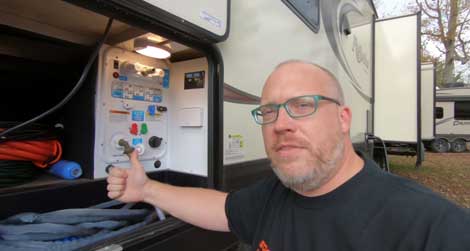
Turn your RV fresh water tank’s outlet valve to the open position. The water will start draining out of your freshwater tank immediately. Be sure to open the fresh water drain valve all the way, or you may not be able to completely empty the tank.
You can use a hose bib to drain water from tanks faster to speed up the process. Once the tank is empty, you can close the valve and proceed with any necessary repairs or maintenance.
Step 07. Check The Water Level:
It’s important to monitor the level of water in your RV’s fresh water tank before draining it. Check the water level in your fresh-water tank periodically to ensure it does not go below the point where the outlet valve is attached. To check the water level, simply look at the gauge on the side of the tank.
It should have a clear indication of how full or empty the tank is. If the gauge is not working, you can also open the fresh water tank valve and use a measuring jug to check how much water is inside.
Step 08. Disconnect Water Hose When Water Flow Stops:
Once the water flow stops, go ahead and disconnect your water hose from the outlet valve. This will help to prevent any backflow of contaminated water into your clean tank.
When the water flow has stopped, close all of the faucets and turn off the pump. Remember that you should never turn on your fresh-water tank without attaching it to an RV freshwater supply first.
Step 09. Turn On Fresh Water Supply & Refill Tank (If needed):
You are now ready to reuse your RV’s fresh-water tank whenever you need it. To do so, simply turn the water supply back on and refill the clean water tank until it reaches capacity.
Once the tank is full, close the valve and begin using the RV as normal. Keep in mind that you may need to repeat this process if you empty the tank again.
Why You Should Know How to Drain Fresh Water Tank?
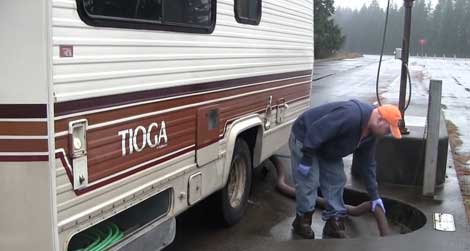
Knowing how to drain RV water tanks properly will save you a lot of time and energy. Having the right tools and knowledge on doing it properly will ensure that there isn’t any wasted water.
Alternatively, you may have to deal with a very wet and smelly situation, which is not an ideal outcome for anyone. By knowing this simple process, you can avoid the need to call a professional every time something goes wrong with your RV’s clean water tank.
Tips for Properly Drain Fresh Water System
Draining your fresh water tank is an important part of winterizing or storing your RV. If water is left in the tank, it can freeze and damage the tank itself. Here are some helpful tips for adequately draining your fresh-water tank:
- Put a pressure regulator in place.
- Make sure to use a compatible water drain hose.
- Keep your fresh-water drain valve open when draining the portable tank to avoid getting clogged up.
- Try hooking up two sewer hoses for a faster drain.
- Keep your fresh-water tank’s level above the drain plug at all times.
- Make sure that you use a bucket or pan to catch any leaks during the draining process.
- Letting food particles get into the gray water tank will add to the odors you smell if you haven’t drained the gray water tank.
RV Fresh Water Tanks: Why Clean Them Before And After Use?
It’s essential to clean your RV’s fresh-water tank before and after each use to prevent any build-up of bacteria or algae. Not only will this make your tanks last longer, but it will also keep your water tasting clean and fresh.
You should also be aware that leaving water in your water tank for an extended period is not only bad for the water tank but can also lead to mold growth. Mold is not only gross to look at, but it can also cause illness when ingested.
Safety Precautions When Cleaning And Draining Tanks?
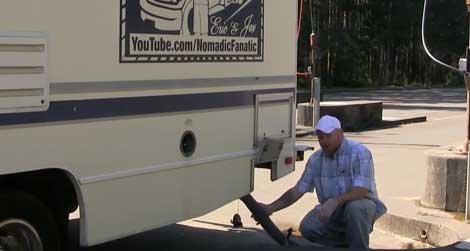
When cleaning and draining your RV’s fresh-water tank, it’s essential to take a few safety precautions to prevent any accidents from happening. Keep these things in mind:
- Turn OFF the freshwater supply to your RV before cleaning the water tank.
- Turn off any anti-siphon drain valves if you have one installed on your RV’s clean cold water lines.
- Always wear gloves and safety goggles when working with detergents or other chemicals that may harm your skin or eyes.
- Do not use any chemicals to help speed up the draining process because they can damage your clean water tank if not used properly.
- Ensure that all drain valves and drain hose connections are closed securely before using your RV’s fresh-water system again.
- If your freshwater tank has an anti-siphon valve, make sure it is closed before using the water tank again.
- Always keep a bucket or pan underneath any potential leak points during the cleaning and drain process.
- Lastly, always turn the water on first and then attach your drain hose when refilling your RV’s fresh-water tank.
FAQs
Here are some frequently asked questions about RVs that people are most interested in:
01. Which Location Can I Empty the RV Fresh Water Tank?
It should be the best filtration tank in any city. The EPA (Environment Protection Agency) has no official rule for where you should drain your water. Because the water isn’t full of bacteria, you can drain it anywhere. You can legally drain your RV fresh-water system into either a household sink, toilet, or storm sewer.
02. Do I Need A Special Hose For My Freshwater Tank?
Your tank should be filled with fresh, potable water from a reputable source using a dedicated water drain hose. For draining, you don’t need a special drain hose for your RV fresh-water tank. Any standard clean garden hose will do the trick.
03. What Is The Best Time Of Day To Drain Your RV Tank?
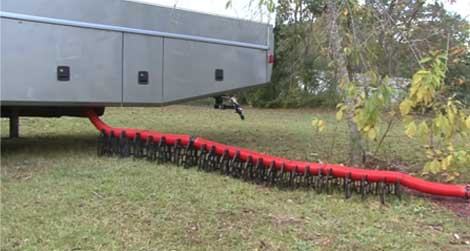
It’s best to drain your RV water in the morning when the temperature is cool. This is because the water will cool down at night, leaving less room for bacteria or algae growth. It’s also a good idea to avoid draining your tank during periods of high humidity, as this can increase the likelihood of unpleasant smells.
04. How Long Can Freshwater Stay In RV Tanks?
You can keep the water tank empty for up to 14 days, as long as you have a water supply on the site. If the weather is hot, it’s essential to keep your tank filled with fresh water. To avoid any potential risks, it is always best to use fresh water as quickly as possible.
05. How Often Should You Sanitize an RV Freshwater Tank?
It is recommended that you sanitize your water tank at least every six months or more frequently if you are in an area where the water is not cleaned regularly. Similarly, if you are using your RV in an area with a lot of wildlife, you may need to disinfect your tanks more often to prevent contamination.
Final Words
Even if you are an experienced RV owner, there is always more to learn. It’s important to know the proper ways of maintaining your tanks. Any standing water or residual matter in this tank must be removed not to contaminate the new supply of clean water when drained into them.
The next time you need to drain the fresh water tank in your RV, you can relax knowing that you know how to do it. Remembering these simple steps on how to drain RV fresh water tank will help ensure that your stay is as enjoyable and relaxing as possible.
